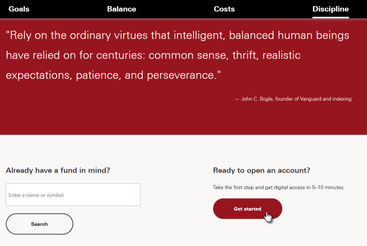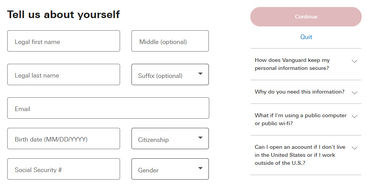Wondering how to buy VTI? And do you need a Vanguard account to buy VTI? These are common questions for new investors that either aren't familiar with ETFs, or they're just having trouble navigating Vanguard's website (and I don't blame you for that! I still get lost on their site once in a while!).
In this post, we're going to talk you through what VTI actually is, how to buy VTI on Vanguard, and we'll even compare VTI vs. similar investments like VTSAX. Ready to research VTI? And ready to start investing? Let's hit it! This post was written by our staff writer, Lindsey Smith.
Similar articles:
10 Best Investment Apps of 2023 (Stocks, Micro, REIT, Crypto, Mutual Funds, +More)
Best Stock Apps of 2023: Online Trading and Investment Apps for Free
What is VTI?
VTI is Vanguard’s Total Stock Market Index Fund ETF. That’s an Exchange-Traded Fund, or ETF, that tracks the Total US Stock Market Index. Every publicly traded company in the US is part of VTI, or just over 3,500 companies. "So, what?"...you might say. Let’s slow that down a little and work out what this all means and why it matters to you.
What is the Vanguard Total Stock Market ETF?
The Vanguard Total Stock Market ETF is every company bought and sold on the US Stock Market. The Index includes small-cap, medium-cap, and large-cap companies. The market capitalization, or market-cap, is simply the company’s worth on the stock market. It is calculated by multiplying the stock's current price with the number of shares open to investors.
The Vanguard Total US Stock Market ETF is a market capitalization weighted index, meaning the companies with the higher market-cap make up a larger percentage of the index. For VTI, large-cap companies make up about 80% of the portfolio, with medium-cap and small-cap companies, or about 3,000 of the companies in the fund, make up the remaining 20%.
Are Index Funds and ETFs the same? What is the difference between index funds and ETFs?
An index fund is simply a group of stocks that follow an index. There are many different indexes, the most popular being the Total US Stock Market Index and the S&P 500 Index. What is great about an index fund is that the market typically trends upwards, even with dips along the way.
Overall, the market always goes up. So when you’re tracking an index like the Total US Stock Market or the S&P 500,as long as you’re in it for the long haul, you’ll see growth. An exchange-traded fund, or ETF, can also track an index like the Total US Stock Market or S&P 500, but they work like a stock and can be traded during the trading day like a single stock.
You’ll get real-time pricing; whatever the price of a share of the ETF is at the time you buy it is the price you’ll pay. Conversely, a mutual fund that tracks an index would have the price set at the end of each trading day, and that is the price you’ll pay the following day.
Why Invest in VTI?
So why might you want to invest in VTI?
One of the best things about VTI is its diversification
A really important aspect in investing is to not have all your eggs in one basket. If you're only invested in one stock or sector and it tanks, you will lose all of your money. Diversification splits your money into a bunch of different sectors or companies, making you a little more safe if one of those companies goes bankrupt.
VTI is also spread across all sectors of the market, including:
tech,
finance, and
healthcare, which further diversifies your holdings.
VTI is weighted with the larger companies
VTI is a market capitalization weighted fund...
so the largest US companies make up the majority of the fund,
the mid-cap companies make up a small part of the fund,
and small-cap companies make up a sliver of the fund.
How VTI Works
The incorporation of small and mid-cap companies is what makes VTI a little better than its similar competitors. Over the long term, these smaller and middle capitalization companies tend to grow at a faster pace than large-cap companies. For example, when Google announced it was going to be included on the S&P 500 - an index that tracks the top performing 500 companies in the US - their stock jumped 7.3% in one day.
The people who had Total US Market Funds (like VTI) were able to capitalize on that growth because they already had Google in their fund. Whereas, those with S&P 500 index funds didn’t see that growth because Google was just being added to their fund.
VTI Expense Ratio (It's super low!!)
Another great feature is how low VTI’s expense ratio is. It typically sits around 0.03%, meaning for every $10,000 you have invested, you’ll pay $3 in management fees.
If you invest through Vanguard’s platform, that is the only fee you’ll pay for investing in VTI. When you compare that with a mutual fund that sits around 1%, compounded over decades it can save you thousands of dollars in fees.
Does VTI have International investments?
Sometimes people are concerned that there aren’t any international stocks inside VTI, since it only tracks the US stock market. But international stocks come with their own added risks. First, investing in a country with an unstable government presents a risk, and even when the government checks out the expense ratios of funds with international stocks is often much higher.
Finally, you could argue that within VTI there are international stocks. Apple, Google, Facebook, and Coca Cola for example, are all US companies that expand across the entire world. In fact, half their profits are from outside the US. They are also largely stable companies, with enough capital to sustain themselves even when the world gets rocky.
Read more:
How Much Does it Cost to Buy VTI?
Let’s talk a little bit first about whether there is a minimum to buy VTI. VTSAX, another fund that tracks the Total US Stock Market Index, requires a minimum investment of $3,000 to start your fund. This is not the case with VTI. There is no minimum to buy VTI. But, you do have to purchase a full share. As of right now, one share of VTI is $227.32, so if you have that much you can purchase a share.
You cannot purchase fractional shares, so you need the exact amount for whatever number of shares you’d like to buy. Because VTI is an ETF, it trades openly on the stock market. Like we talked about, that means you’ll get real time pricing, the price you see when you buy is the price you pay, and it could go up or down as the day goes on.
Do I Need a Vanguard Account to Buy VTI?
There are options from a lot of different investment companies for Total US Stock Market Index Funds, but if you want to buy an ETF and you want VTI, you will need to invest through Robinhood or Vanguard.
While the expense ratio on both platforms is extremely low, because VTI is Vanguard’s Total US Stock Market Index Fund, the ONLY fee you’ll pay when using Vanguard’s own platform is 0.03%. We also love Vanguard because they are owned by their funds, which are in turn owned by investors like you and me. Vanguard makes decisions in our best interest because they make money when we make money. For that reason, we’ll walk you through buying VTI through the Vanguard brokerage platform.
How to Buy VTI on Vanguard
First, you’ll need to open a Vanguard account.
How to Open a Vanguard Account So You Can Buy VTI
1. Create an account
2. Answer some questions
3. Select funding method
4. Confirm you're new
5. Get your details ready
6. Choose account type
7. Select investing goals
8. Fill in your personal details
9. Connect your bank account
10. E-sign some documents
How to Invest in VTI
1. Sign in
2. Go to your investments
3. Add your money
4. Choose fund
5. Put money into chosen fund
6. Fill in amount
7. Choose source of funds
8. Submit
VTI, VTSAX...or VOO?
While VTI, VTSAX, and VOO are all great funds, you definitely only need one. With so many options for ETFs or Total US Stock Market funds, it can get a little challenging to figure out which is best for you, so here we’ll go over these three funds so you can decide if VTI is what you’re looking for, or if another fund might suit you better.
VTSAX vs. VTI
VTSAX and VTI are both funds with Vanguard that track the Total US Stock Market Index. What’s great is that VTSAX is set up nicely for automatic contributions, however in some cases you can set up automatic contributions into an investing account and then set up automatic purchases of VTI.
Of course, you can do both manually, but you’re more likely to stick to an investment schedule when it comes out of your paycheck every week without you touching it first. VTI and VTSAX both have similar expense ratios, sometimes moving up or down by 0.01%.
More importantly to us, they are both the same investment vehicle, containing the exact same stocks. They generate the same return every single year and have the same dividend yield. Investing in both is redundant because they are the same portfolio of companies.
So why invest in VTSAX and VTI?
VTSAX requires a minimum investment of $3,000 to initiate the fund. Once you invest that initial lump sum, you can buy at any amount you want. Meaning yes, you can buy fractional shares once you put that first $3,000 in. VTI has no minimum purchase, as long as you can afford one share you can buy it. But it does not offer fractional shares, so you’d need to contribute to your settlement fund and then when you have enough, purchase a full share.
We’ve also talked about how VTI has real-time pricing, but VTSAX is not an ETF, so is not traded like a stock. The price is set at the end of the trading day, and that is the price you’ll pay the next day, no matter what time you purchase. This is a negligible difference if you’re investing over the long term, since the hour-to-hour fluctuations aren’t going to matter much in 30 years.
VTI vs. VOO
VOO is Vanguard's S&P 500 Index Fund ETF. So here, we’re comparing two ETFs, one that tracks the Total US Stock Market Index (VTI), and one that tracks the S&P 500 Index. The S&P 500 stands for Standard & Poor’s 500 Index. It tracks the top performing 500 US companies.
This index is regarded as the best indicator of all US large-cap equities, or simply, the performance of large company stocks. Even though VOO contains the top 500 companies, about 20% of the fund is made up of just the top 5 holdings:
Apple,
Microsoft,
Amazon,
Facebook,
and Google.
Related
How to Invest in VOO (...and What is it Really?) One of the things that makes this index fund great is that it’s self-cleaning.
The companies valued the highest rise to the top and make up the larger part of the fund. As companies shift and change they fall off or rise up, which means you’re always invested in the top 500 companies.
You could argue that VOO is less volatile because it contains all large-cap, relatively stable companies.
However, VTI is more diverse for including large, medium, and small-cap companies and, as we saw with the Google example, there’s potential for larger gains.
Investing in VTI also includes all the companies inside VOO, plus about 3,000 more.
The expense ratios are the same, at 0.03%.
Historically, they both perform similarly.
However VTI’s performance potentially has a slight edge in the long run, because it includes a mix of large, small, and medium-cap companies.
In the end, you should definitely include index funds and ETFs in your portfolio. A Total US Stock Market Index fund like VTI is a low-barrier to entry ETF that has excellent diversification and outpaces its competition in the long run. Of course, always invest in whatever keeps your mind at ease, and allows you to keep investing more on a continuous basis.
How to Buy VTI - Are You Ready to Pull the Trigger?
So how about you? Now that you know how to buy VTI, will you?? It certainly sounds like a solid investment with a 10-year return of 14.7%! Of course, this doesn't mean the next 10 years will produce the same results. But, it does have a great track record thus far.
Are you ready to start investing in VTI? If not, what's holding you back?







.jpg)




